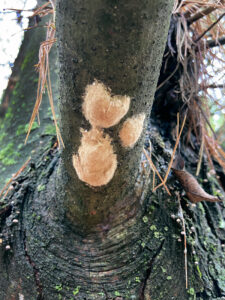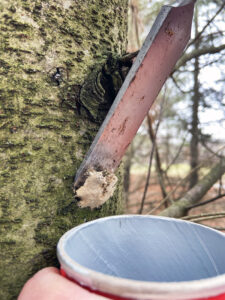By Bill McNee, DNR Forest Health Specialist, Oshkosh;
bill.mcnee@wisconsin.gov or 920-360-0942

Three spongy moth egg masses are found on a tree branch at Kettle Moraine State Forest Southern Unit in Walworth County. / Photo Credit: Bill McNee, Wisconsin DNR
The Wisconsin Department of Natural Resources (DNR) is encouraging property owners to seek out and dispose of spongy moth egg masses, which were produced by adult moths during the summer.
Each spongy moth egg mass contains hundreds of eggs that will hatch into hungry, leaf-eating caterpillars in the coming spring. Large numbers of these invasive caterpillars can be a tremendous nuisance that may cause tree mortality.
Treating or removing egg masses in the fall will help to reduce the pest population and can help to reduce the intensity of tree defoliation next summer.

Carefully scraping spongy moth egg masses off trees into soapy water will help to hold down caterpillar damage in 2024. / Photo Credit: Wisconsin DNR
To remove spongy moth egg masses, spray the masses that are safely within reach with horticultural, mineral or neem oil (available online or at local garden centers and many big-box stores), or gently scrape them into a container of soapy water to soak for two days before throwing in the trash. Do not use motor oil or other lubricants, as these can harm the tree and be a pollutant. Old masses with no viable eggs will appear faded and will feel spongy when touched.
Checking for egg masses also helps property owners predict the level of nuisance caterpillars and tree defoliation that is likely in 2024. Those estimates can, in turn, help landowners and managers decide if action should be taken in the spring.
Spongy moth populations remain high in many areas of the state, and while an overall population decline has been observed in southern Wisconsin, egg mass numbers still remain high enough to cause nuisance problems and heavy tree defoliation in some locations.
Areas that saw increasing caterpillar numbers and many adult spongy moths this summer are likely to have high egg mass numbers and are at high risk for a large pest outbreak in 2024. Some areas will have a continuing outbreak, and some will see the outbreak decline.
Populations usually grow fastest and are often first noticed on:
- Preferred tree species (oak, crabapple, birch, etc.) growing in mowed lawns
- Large oaks with rough bark, especially in or adjacent to mowed lawns
- Dry sites with sandy soil and abundant oak
Visit the Wisconsin spongy moth portal for information about egg mass oiling and removal, physical controls, population survey methods and insecticide applications to high-value host trees. An arborist or forester may also be a good resource for anyone dealing with spongy moths.
